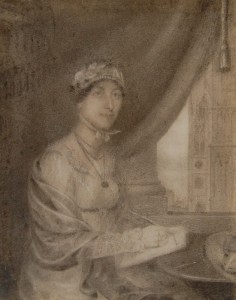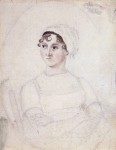 Austen biographer Dr. Paula Byrne believes she has found a lost portrait of the author. The graphite on vellum drawing depicts a Regency-era woman sitting at a desk, writing, with Westminster Abbey visible through the window behind her. “Miss Jane Austin” is written on the back. Byrne received the portrait from her husband who bought it at auction from a specialist who had just been told by an Austen expert that the portrait was not Jane Austen but rather an imaginary vision of her drawn by someone who never saw her.
Austen biographer Dr. Paula Byrne believes she has found a lost portrait of the author. The graphite on vellum drawing depicts a Regency-era woman sitting at a desk, writing, with Westminster Abbey visible through the window behind her. “Miss Jane Austin” is written on the back. Byrne received the portrait from her husband who bought it at auction from a specialist who had just been told by an Austen expert that the portrait was not Jane Austen but rather an imaginary vision of her drawn by someone who never saw her.
Byrne found the figure compelling, mainly the nose which bears a striking resemblance to the noses of other members of Jane Austen’s family. Inspired by the nose and the name on the back, Byrne decided to research if it might actually be an authentic portrait after all.
“When my husband bought it he thought it was a reasonable portrait of a nice lady writer, but I instantly had a visceral reaction to it. I thought it looks like her family. I recognised the Austen nose, to be honest, I thought it was so striking, so familiar,” Byrne told the Guardian. “The idea that it was an imaginary portrait – that seemed to me to be a crazy theory. That genre doesn’t exist, and this looks too specific, too like the rest of her family, to have been drawn from imagination.”
Byrne pointed out that Austen did not become famous until 1870, 50 years after her death, and the portrait has been dated to the early 19th century, around 1815, on the basis of the subject’s clothes. “Why would someone have wanted to draw her from their imagination, when she was not popular at that time?” she asked.
Couldn’t they have imagined Regency clothes while they were at it? They need to find a better way to date the portrait than the clothing of the sitter, it seems to me. Also, Jane Austen never lived in London, so why is Westminster Abbey behind her? Doesn’t that suggest a symbolic view of a writer acknowledged to be great? In 1815 Austen was still alive; her books were published anonymously until after her death.
 Byrne seems to think this representation of Austen as an important writer argues in favor of the portrait’s authenticity. Since Austen didn’t become wildly popular until a sentimental biography of her by her nephew, James Edward Austen-Leigh, was published in 1870, fan art from that era tends to be in keeping with that homey spinster Aunt Jane presentation.
Byrne seems to think this representation of Austen as an important writer argues in favor of the portrait’s authenticity. Since Austen didn’t become wildly popular until a sentimental biography of her by her nephew, James Edward Austen-Leigh, was published in 1870, fan art from that era tends to be in keeping with that homey spinster Aunt Jane presentation.
“The previous portrait is a very sentimentalised Victorian view of ‘Aunt Jane’, someone who played spillikins, who just lurked in the shadows with her scribbling. But it seems to me that it’s very clear from her letters that Jane Austen took great pride in her writing, that she was desperate to be taken seriously,” said Byrne. “This new picture first roots her in a London setting – by Westminster Abbey. And second, it presents her as a professional woman writer; there are pens on the table, a sheaf of paper. She seems to be a woman very confident in her own skin, very happy to be presented as a professional woman writer and a novelist, which does fly in the face of the cutesy, heritage spinster view.”
 The image of Jane Austen on the front page of the biography was a softened, filled-in version of an unfinished sketch thought to have been done by her sister Charlotte in 1810. That sketch of Charlotte’s is the only uncontested portrait of the author because it came from the family, but even so there are doubts about its authenticity because it’s not signed, dated nor is the subject named. Oh, and it looks nothing at all like Byrne’s drawing.
The image of Jane Austen on the front page of the biography was a softened, filled-in version of an unfinished sketch thought to have been done by her sister Charlotte in 1810. That sketch of Charlotte’s is the only uncontested portrait of the author because it came from the family, but even so there are doubts about its authenticity because it’s not signed, dated nor is the subject named. Oh, and it looks nothing at all like Byrne’s drawing.
Byrne and the BBC, who will be airing a documentary about the portrait and Jane Austen on Boxing Day, took the drawing to three top Austen scholars. After close examination, two of them, Professor Kathryn Sutherland from Oxford University and Professor Claudia Johnson from Princeton, agreed that the drawing is an authentic portrait of Jane Austen. A third, Deirdre Le Faye, disagrees. She believes it is an imaginary portrait, that there are too many things wrong with it.
Here’s a brief interview with Byrne wherein she summarizes her argument. Here’s a BBC video where dissenter Le Faye makes an appearance and you get to catch a glimpse of a rather cool Austen nose lineup at the 1:16 mark.
It’s pity that the support is vellum not paper, so there is no datable watermark. However, the drawing rather feels like a posthumous image–at least to me. The obvious implication is that she deserves burial in Westminster Abbey (which is difficult to imagine for J.A. pre-1870). And what is that on her head? Even if it is not quite a laurel wreath, there might be the implication of one. Westminster Abbey was considerably restored in the mid-19th century. Is it too much to hope that there might be a tell-tale George Gilbert Scott window behind the authoress?
I agree that it’s probably a posthumous depiction. I gather (it’s not clearly stated in any of the news stories) that Byrne imagines the Westminster setting and accouterments of the writing trade are something Austen herself wanted because it was important to her that she be seen as a serious author, not a dabbler. Would she have asked for someone to draw her like that, though? It seems incredibly cocky.
Let’s see some analysis of the ink used to write “Miss Jane Austin” on the back. Surely that’s the most datable element.
It’s a pity this blog was written before the BBC programme was broadcast. There are half a dozen lines of evidence pointing to authenticity: that particular fashion with high waist and high neck lasted only about 1812 to 1815 and would be difficult to get right retrospectively; Jane was in London just then, 1813-15; barium sulphate, the white pigment, was popular at that time and not later; the composition of the ink too is characteristic of the early 19th century; there is the typical nose of the Austen family; St Margaret’s Church in the background is where the presumed painter was married; and the misspelling, ‘Austin’, on the back, was used by several people, even including Jane when she signed for the royalty cheque made out to her with that spelling. It all adds up.
I was skeptical too, but the documentary (i.e. the evidence Philip Stewart’s post points out) actually makes quite a compelling case. I’ll be interested to hear your thoughts after watching it 🙂
Oops, just realised I’m a year late in commenting… 😮
Her sister’s name is Cassandra, not Charlotte.
In the BBC programme they show a lot of indications to prove that the girl on the portrait is Jane Austen. I also agree that it’s authentic.
It’s such a pity that a great writer as Miss Austen only got recognition for her work at a later stage. At that time it was very difficult to set up a writing career as a woman. That’s why I’ve always appreciated her work!